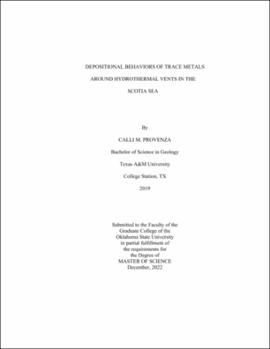| dc.contributor.advisor | Riedinger, Natascha | |
| dc.contributor.author | Provenza, Calli M. | |
| dc.date.accessioned | 2023-08-02T19:47:17Z | |
| dc.date.available | 2023-08-02T19:47:17Z | |
| dc.date.issued | 2022-12 | |
| dc.identifier.uri | https://hdl.handle.net/11244/338805 | |
| dc.description.abstract | Sediment deposition along the East Scotia Ridge (ESR) in the Southern Oceanis dominated by biogenic sediment due to its location within the diatom belt and is
influenced by the Antarctic Circumpolar Current mainly flowing west to east.
Hydrothermal vent systems occur along the ESR, are characterized by nine
tectonic segments (E1-E9). Sediment cores in the vicinity of ridge segments E2
and E9 from the ESR were analyzed to gain a better understanding of potential
vent fluids related to trace metal distributions in surrounding modern marine
sediments. Solid phase multicore and porewater samples collected during the R/V
Polarstern Expedition PS_119 were located on both east and west sides of the
ESR. Samples were selected at different distances from the hydrothermal vents
along two west to east transects crossing E2 and E9 to gain a broader
understanding of how chemical signatures within the sediment column change
due to their proximity to the vents. As hydrothermally emitted plumes move
throughout the water column, they affect where trace metals are deposited onto
underlying sediments. Each core was analyzed using an inductively coupled
plasma mass spectrometry. Analysis across the transects show a steady increase in
trace metal concentrations on the eastern side of the ESR compared to samples
from the western side indicating a currents-induced eastward movement of
hydrothermal plumes from the ESR. In addition, sediments near E9 exhibited
much higher trace metal enrichments compared to segment E2 signifying a more
trace metal-rich magmatic substrate source and different water-rock interactions
increased metal concentrations within plumes and their deposits. Understanding
the effects of hydrothermal activity on marine sediment is crucial when studying the productivity of an area using trace metal proxies because trace metal input from hydrothermal vents can overprint chemical signatures left from
phytoplankton in marine sediments. Silver seems to be relatively unaffected by
hydrothermal activity as it has similar concentrations within the cores analyzed,
while cobalt and copper concentrations fluctuated with different distances from
the hydrothermal vents. Thus, copper and cobalt have the potential to indicate
changes in deep ocean currents, while silver may be a good productivity proxy in
the Southern Ocean. | |
| dc.format | application/pdf | |
| dc.language | en_US | |
| dc.rights | Copyright is held by the author who has granted the Oklahoma State University Library the non-exclusive right to share this material in its institutional repository. Contact Digital Library Services at lib-dls@okstate.edu or 405-744-9161 for the permission policy on the use, reproduction or distribution of this material. | |
| dc.title | Depositional behaviors of trace metals around hydrothermal vents in the Scotia Sea | |
| dc.contributor.committeeMember | Burkett, Ashley | |
| dc.contributor.committeeMember | Quan, Tracy | |
| osu.filename | Provenza_okstate_0664M_17986.pdf | |
| osu.accesstype | Open Access | |
| dc.type.genre | Thesis | |
| dc.type.material | Text | |
| dc.subject.keywords | East Scotia Ridge | |
| dc.subject.keywords | geochemistry | |
| dc.subject.keywords | geology | |
| dc.subject.keywords | Scotia Sea | |
| dc.subject.keywords | trace metal deposition | |
| thesis.degree.discipline | Geology | |
| thesis.degree.grantor | Oklahoma State University | |
